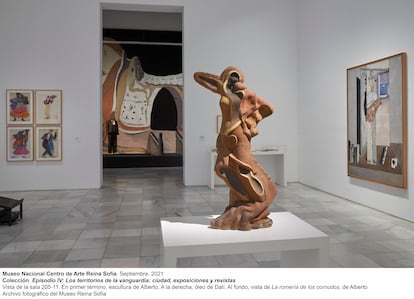The complete film of what will be the new version of the Reina Sofía collection, which can be seen in November, offers from today a new preview in the rooms on the second floor of the Sabatini building.
This trailer, the fourth, affects one of the most recognizable parts of the museum, what was the seed of the avant-garde of the twentieth century.
There are some 400 works that cross the national and international territory and whose borders could be the dark characters of Julio Romero de Torres and the moment in which Picasso painted the famous
Guernica
.
In between, there are numerous stories that sprouted from the cities and their radical industrial transformation, broadening the concept of art with a look abroad that would end up merging with such popular manifestations as flamenco.
More information
The hostesses who returned the 'Guernica' to Spain
Museums want to go green
Before breaking down the new episode, the director of the museum, Manuel Borja-Villel, explained that in this section everything happens in cities. The artists look at the social conflicts due to the miserable living conditions of the proletariat and put their talents at the service of the denunciation. Photography and cinema are experiencing an impressive boom at the turn of the century that can be seen in the social photography series of the Americans Lewis Wickes Hine and Paul Strand. Along with the overwhelming close-ups of Strand's work hangs a series by an anonymous author in which violent police charges are collected during the Tragic Week of Barcelona (1909). The vintage copy is a recent museum purchase and can be viewed with the help of magnifying glasses placed next to the small-format photographs.
The city of Barcelona is also the scene of the architectural and urban transformations demanded by the new times to improve the life of the bourgeoisie and replace the unsanitary barracks on the periphery with decent housing. Models, plans and videos document what the plan of the architect Ildefonso Cerdá meant in Barcelona's Ensanche, together with the proposals of the La Flor de Mayo cooperative, where neighborhoods with green areas, schools and markets were proposed for the first time. Rosario Peiró, director of the collection, clarifies that this space dedicated to architecture will be completed with a contribution on the transformations and struggles of the city of Madrid with sections of Gutiérrez Solana, el Rastro or Arturo Soria dedicated to the city.
Faced with the new urban proposals, what was a nineteenth-century painting room is recreated where painters narrate their concern about the anarchist attacks and revolts of the time. Large-format oil paintings hang here, such as
Prisoners' Rope
(1901), by José María López Mezquita (1883-1954);
Vile garrote
(1894), by Ramón Casas;
Quiet Conscience
(1897), by Julio Romero de Torres;
The night of San Benito
and
Memory of the pitas to Martos O'Neale
(1903), by Antonio Fillol.
The section dedicated to the cities closes with two jewels that until now had only been partially seen. One is the series of radical drawings that the German George Grosz began to make in 1910 and which he later collected in the
Ecce Homo
notebook
.
The other jewel is the projection of the film
La Commune,
shot in 1914 on the Paris Commune of 1870. Made by the Spanish anarchist Armand Guerra, it is considered one of the best testimonies of what was the first proletarian revolution against the bourgeoisie.
The tour of this chapter of the collection takes up the scene of the Catalan capital to tell how the Spanish neutrality in the First World War turns Barcelona into an artistic center of the first order. Many creators settle in Barcelona (Los Delaunays, Arthur Cravan) and the painter and dealer Josep Dalmau opens a gallery through which all the great European trends are introduced to Spain. Here the exhibition that he dedicated to Francis Picabia is partially reconstructed and paintings linked to those exhibitions with works by Rafael Barradas, María Blanchard, Salvador Dalí, Juan Gris, Albert Léon Gleizes or Joan Miró are exhibited.
Then come the cultural magazines such as
El Meridian
and
Documents,
which gave rise to intense debates between critics and artists. Along with the display cabinets where the different specimens are kept, the already powerful and controversial Dalí offers one of the most surprising stops with three large oil paintings exhibited together for the first time:
Untitled
(1928),
Four Fishermen's Women in Cadaqués
(1928 ) and
Abstract Composition
(1928). In front of the canvases the short film
Comiendo erizos
(1929), shot in Cadaqués by Luis Buñuel and starring the painter's parents,
is projected
.
The role of cultural workers enters with photographs and documentaries of the Pedagogical Missions that are exhibited together with a wide series of posters of La Barraca, the traveling university theater created by Federico García Lorca. This installment ends with a tribute to flamenco singing, which many avant-garde artists incorporate into their works through motifs such as the guitar painted by Manuel Ángeles Ortiz, the fan by María Blanchard or the costumes of Spanish dancers designed by Natalia Goncharova.

